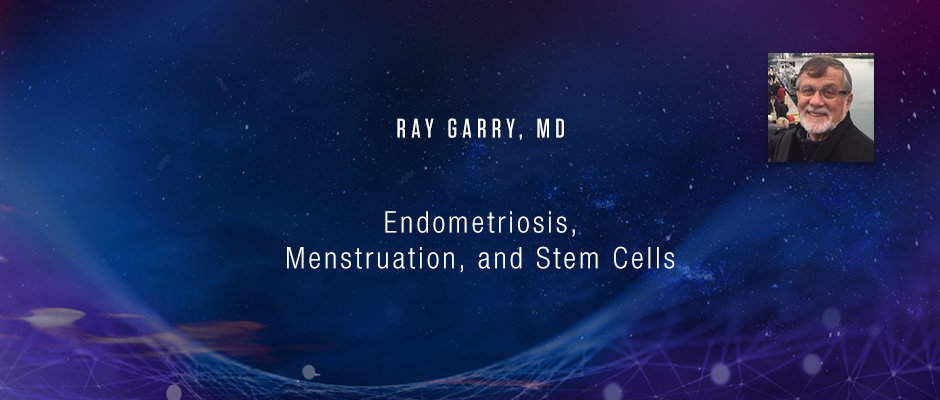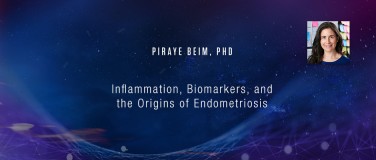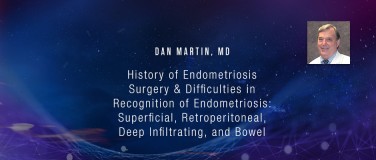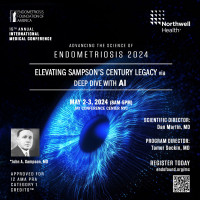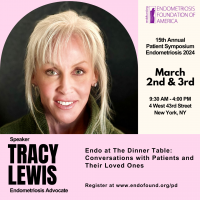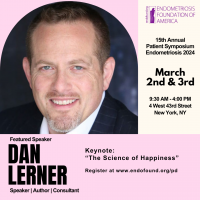Endometriosis, Menstruation, and Stem Cells
Ray Garry, MD
Endometriosis Foundation of America
Medical Conference 2019
Targeting Inflammation:
From Biomarkers to Precision Surgery
March 8-9, 2019 - Lenox Hill Hospital, NYC
https://www.endofound.org/medicalconference/2019
Good morning, and thank you very much indeed to Tamer and Harry and the foundation for giving me this opportunity to be in this fantastic bit of this amazing city and to share this time with you.
Harry is one of my best mates as well as an inspirational mentor. I was already a little apprehensive about this talk, but last evening with Harry and David, we had a little chat, which made me realize just how far off message I've strayed with this study I'm about to talk about.
My story is that for most of my professional life I worked in the Northeast of England in NHS practice. NHS that we all love in Britain, and you all hate in America, but anyway, I was working in a very busy practice with loads and loads of patients, which gave me the basis to doing lots of trials and assessments some of which you'll hear about tomorrow.
But when I went, I received a very surprising invitation to go to Australia to be the chair in Western Australia there. Life was very different apart from the fact that the sun shone all the time, I had a chair, and I sat in that chair, and sometimes I sat and thought, and sometimes I just sat, but I didn't have very many patients. I just had a few very severe endometriosis patients, but I did have access to some very interesting tools which I had not previously had access to.
So, I could've called this talk a study of the structural changes that occur in the endometrium throughout menstruation. Most of this talk is about menstruation alluded to endometriosis a little bit, but we're using three modalities: Hysteroscopy, immunohistochemistry, and electron microscopy to try and get a better feel of what actually happens during menstruation.
I have to acknowledge the work of Julie Crew, and I hope you'll think that some of these images are really rather fantastic, and they're all down to her and not to me. But the idea is we got images which gave us a whole impression of what was going on, and you can see here the late secretory phase endometrium and the compact zone with lots and lots of cells stuck to it.
Now, we know the endometrium changes throughout the cycle. This is beginner's stuff, but the surface epithelium is very different in the proliferative phase and in the secretory phase. I'm sure you all know this. This is introducing ... Can I get the ...? Ah, that's the laser. This is obviously early proliferative phase, and this is using an antigen KI-67, which is a proliferative marker. Every little brown spot is a cell that is actively dividing, hence the proliferative phase. We know everything there is dividing, dividing, dividing like mad to produce the secretory phase like this.
Now, this is stained with an antigen CD-34, and as you'll see, there is a layer of CD-34 antigen in the upper half of the basalis of the endometrium.
Now, if you look up, and I'm no expert in stem cells as it will become very apparent, but if you look at ... Oops, sorry, I have to go backward. If you look up at what CD-34 antigen is expressed on hematopoietic stem cells, and at first, I was very excited thinking, "Well, this is a job done. There are a load of stem cells just lying around there." But I was advised by those who know better that there are many other functions of CD-34, but it mainly accesses an adhesion factor that attaches stem cells to the bone marrow matrix, and it also facilitates cell migration and homing.
So, these functions of this antigen, and you'll see the significance or I presume significance. Now, what I hadn't appreciated before is that as well as changes across the menstrual cycle, there were zoning changes that at different levels different cells were present. Here you can see two identical, the same piece of tissue stained here with CD-34, and here with a different stain which is CD-56, which is uNK cells.
Now, these uNK cells are quite amazing. They increase throughout the cycle until, at the end of the cycle, there are enormous numbers of these things around. Now, what do they do? What are the functions of uNK cells? Well, they are basically there to modify the immunology of the local endometrium. You will find that at the core of all this is that the fertilized embryo is antigenically different as you know to the mother, and therefore the mother has to do something very clever in altering the local immunology around here whiles preserving her general immunological function. If they don't this will be rejected immunologically every time. So, this is a clever thing.
Now, why you ladies ...? No, I said ladies, this is New York, you women may wonder why you actually have to go through menstruation at all? It is vaguely we all think, but clearly related to pregnancy, and you can't get pregnant unless you menstruate, so this is a straightforward thing, but when we think about it almost all mammals don't menstruate. Dogs and puppies and rabbits and sheep and everything don't menstruate. Only the higher primates, women in the higher primate, and these two charming little fellas are the only mammals to actually menstruate.
Now, why should that be? I'm suggesting it may well be about the presence of these CD-56 because what's different between women and a dog or something is ... Let me think, but obviously, the main thing is that women anticipate the arrival of a fertilized embryo and that anticipation requires the production of all these CD-56 cells, these uNK cells, which are there to modify the immunological response of the host.
Now, when pregnancy doesn't arrive, these cells have got to be got rid off. Sorry, I didn't point out that. Sorry, just a minute. Oh, I've lost it. Okay, anyway. So, uNK cells, we know that under the influence of progesterone uNK cells produced positive cytokines which are involved in the structural and immunological preparation of the endometrium and virtually no cytotoxic activity, but when progesterone is blocked this inhibition effect is removed, and this can be done experimentally with pristone or something or physiologically at the end of the cycle the cytotoxic activity of these millions and millions of cells that are in the endometrium is upregulated. This has just been known recently.
So, it's first my point here is that the problem uNK cells may be both the problem in the endometrium during the cycle, and also the solution. The endometrium obviously gets flooded with uNK cells in anticipation of the embryo when conception does not occur these toxic cells need to be removed, but how better to remove them than they themselves produce their toxic material.
However, it happens, the endometrium comes off in little chunks. In little pieces, here and here on hysteroscopy examination. When the piece is torn away, what you can see is torn glands. They wave about in the distinction fluid, they look like seaweed in the sea. Some of these torn areas are in fact torn blood vessels, ripped off, and so hence the bleeding. This is what the surface of the endometrium looks like on electronmicroscope, and just this time has torn vessels and little filaments of stuff with few cells stuck together.
The vascular supply has to repair phenomenally quickly. Clearly, you can't have a repairing anything without a good vascular supply, so the vascular supply that we've seen it, most of it has just been ripped off, and a few standing vessels are pumping away. This is on day one. This is already healed in this area with a new vascular supply, and just that one little vessel still pumping.
So, one of the things I want to tell you about is just how quickly these healing processes occur. We tend to think beyond specifically if a period lasts for five days, it takes five days for it to get better. I would tell you it takes maybe five hours or maybe even just five minutes for pieces of the endometrium to heal. I think this is what's confusing.
Now, as far as new blood vessels are concerned it's been established for a long time by lots of very skilled workers that when the acute ischemia, it isn't androgenesis, it isn't cell division that repairs the vessels, it's bone marrow endothelial progenitor cells which is assumed from the bone marrow to the point of hypoxia. So, this happens anywhere in the body, but it's very likely that this mechanism is responsible for this very rapid repair of endometrium.
Now, this is the other quite important side I want you to see, because I think this is, so scanning electronmicroscope of day one, and you can obviously see large areas haven't been shed at all. Some areas have been shed all over the place, and that's fine. This is good for the patient. We know the endometrium isn't all shed at once, but it's shed in little bits. This is energy efficient, it minimizes the area that is exposed to infection, etc, at any one time, and it maximizes the healing. But what I want you to believe ... Oops, sorry, I want to go back. What I want you to believe is that these areas are already healed and that they're coexisting in the same specimen unshed, shedding, and healed endometrium.
I think this is a nightmare for laboratory workers who are trying to measure things in the endometrium at any one time, 'cause you need to know not just that it's day one of the endometrium, but which bit have you got? Which bit have you sampled? It can be obviously a major problem. Here, this is just showing some obviously unshed and shed and some glands, and here is an unshed bit and whatever, quite obvious.
Here is a little bit farther advanced, and you can see the endometrium glands are being further shed, and here on this particular one, very dense staining of CD-34 cells. This is constant. It's in every endometrium, at the upper half of the basalis, the bit that's exposed to the surface once the endometrium is shed. There's also CD-34 around the glands as well as in the blood vessels which has been there for a long time.
Okay. This is a remarkable photograph because it's a composite of a lot of pictures, but it's showing the endometrium being shed, its bits falling off and exposing the CD-34 there.
This is another photograph of the same bit this time stained with uNK cells, and you can see the uNK cells, you can imagine if they are activated if they are cytotoxic. This is maybe what's driving this endometrial shedding process.
This is a slide showing a little bit of endometrium which is still retained. It's semi-transparent. You can see the gland through, and this white bit is already healed.
Okay. Now, the bit about this, what do you think the similarity between this and this is? The answer is not very much histologically except it's from the same patient on the same day or with the same preparation. So, the question is how does it get from ... Oops, sorry, from the first to that second?
Now, the theory which we were all brought up in, and it's still in the textbooks, I think, was a theory described by two eminent American pathologists, Novak, and Te Linde, in 1924. They based their study on 12 cases. They said that essentially that the epithelium was repaired chiefly from the endometrium growing out from the basal glands. They tried to show this diagrammatically that they believe these glands were left and they just had undergone mitotic and very quickly the epithelium was restored in that manner.
Now, I ask you, this has been the theory for maybe 90, 100 years, and it's absolute garbage. It couldn't possibly have been correct. This is the endometrium gland at the time of shedding, and you can see it's fully differentiated cells, great big columnar epithelial cells with microvilli and lots of ... So, that couldn't, couldn't change into this within a few minutes. It's garbage.
And you remember the first slide I showed you, the proliferative phase with the proliferation marker KI-67? This has got proliferation marker here, two cells. So, this is day one specimen already a new piece of epithelium healed, but it appeared without any cell division, okay? So, it's come from somewhere but it hasn't come from the glands, and it hasn't come ...
Now, it's all very well me as a clinician saying this, why have the pathologists told it is before? Well, the answer is they had, or at least somebody had. This statement was made in 1933 that the rapidity of the epithelization and the lack of mitotic figures cannot well explain by the generally accepted theory that the uterine epithelium regenerates from the epithelium of the deep glands. Who said that? This gentleman, who is perhaps an even better-known pathologist than the others 'cause this is Papanicolaou who went on to do pap smears.
It's one of those interesting questions you might ask yourself is why do some people's theories get accepted and retained for many, many years than somebody else's theory proposed a few years later with completely sound thing not be accepted at all? It's really quite an interesting thought.
Papanicolaou went further than that. He actually showed this animal work to show what he thought happened, is that the endometrium, the glands, were shed into the glands, and then there was glandular differentiation to regrow. Now, that's fine, but to the best of my knowledge, this hasn't been particularly described in the human. Does it happen? Yes, I think it does.
This is a patient I actually saw in early day one, lost the surface endometrium. Those glands disappear although here. There's a gland here with some attempts on these old cells or new ones, but anyway something fairly dramatic is happening there.
Here is another case, where I think exactly what Papanicolaou described was happening. Here, the most important slide I think demonstrates beyond doubt. This is not just an artifact of preparation. Here are some new cells, and here are what [inaudible 00:19:25] like new cells not in the endometrium, and it looks just as if somebody has got a bicycle pump and is pumping them up. They're actually just growing before your eyes, if you like. I think this is why it's been missed, that unless you look at precisely that time before or after the glands look fairly normal, but it's only just if you catch this.
If we actually go back one, I didn't mention it but the stain we showed here was CD-117, which is C-Kit. Now, I know even less about C-Kit than these other things, except to say that C-Kit its ligand for C-Kit is called Stem Cell Factor, and their function is also to mediate cell survival, proliferation, and migration of stem cells.
So, let's say it's somebody who knows as little about stem cells as I do that both these cells, CD-34 and CD-117 or C-Kit are actually concerned with stem cells; migration, adhesion, and something else.
Okay, and this is another slide, this of day one healing, and you can see these brown-y color thing, these are all C-Kit cells packed into the area just below healing.
So, this is what this chaotic healing process looks like at the very early stages. What there is not is the odd gland here. There are not streams of epithelial cells boring out of these glands, so I think we can categorically take this out of the textbook, but this is what it really looks like. It's this matrix of fibrinous material here. Here is your torn blood vessel with obviously red blood cells, but every sort of cell coming out, bearing in mind this is a mess that could trap cells, and obviously it's trapping cells, bearing in mind that it's got two different cells whose function is stem cell adhesion that it's quite possible, no probable, you see all these cells, these are three macrophages, and I don't know what these funny shaped cells are, but everything that's in the blood can be in the blood, can be in this area, and specifically pumped out just these areas of need.
So, if I can summarize this bit and say what facts have we established? Well, we know that small pieces of the surface endometrium are shed, and they coexist with shed, unshed, and healed areas.
We know that pre-shed surface endometrium contains abundant uNK cells that seem to be somehow involved in this process of shedding. The repair is rapid and without mitosis.
Glandular epithelium are simultaneously shed and almost instantly replaced, and the repair occurs near CD-34 and CD-Kit cells that are markers for and regulators of stem cell homing and adhesion into fibrous matrices.
So, on those facts, I've had to be merited to come up with this hypothesis that blood bone stem cells or progenitors home from the bone marrow specifically to areas of healing hosing down just onto those individual areas of healing rapidly differentiate into new epithelial and endothelial cells.
What's that got to do with endometriosis? Well, maybe nothing at all, but when you think about what we all recognize as endometriosis, the pathognomonic marker, whatever we say about the fancy things, are the little black areas. The areas of hemorrhage.
I hadn't thought until very recently about what's happening in those areas? What are they doing? Why is it bleeding into these tissues? It isn't a self-given right for blood to leak out, so could it possibly be that the same thing is happening in the endometrial deposits? Is this happening in ectopic endometrium? Could the endometrial deposits themselves be shed in a cyclical manner?
Well, here is a deposit into a uterosacral ligament, and you can see it's surrounded by a color of CD-34 cells.
Here's another one, very clear example in the rectal deposit of a definitely endometriotic lesion surrounded by the CD-34. Now, if this is not stem cells or something to do with it, what are they doing there? What's that form? Has it to do with blood vessels? Is it? I don't know, but they are certainly there.
Here's another one, and another one, but the fundamental question that I want to pose is could these things shed? I'm going to propose a theory based on one slide in one case which is not a very strong scientific ground, but this is an ectopic gland, which I think shows the same things as we demonstrated before, surrounded by CD-34, the epithelium is being shed and there are little potential progenitor cells underneath it.
So, I'm leaving you with the question of, is endometriotic epithelium also shed and replaced cyclically by bone marrow-derived cells? If it is, then it then this is a whole kind of world about etiology and management and other options. I'm totally aware that I haven't proven this, but there are some strong anatomical features which suggest that this may be the case. Thank you very much.
Can I ask one question before ... Just for the last slide that you showed, I mean why can't you think that those CD-34 positive cells could be endometrial or endometrial stromal cells? They do express CD-34.
Yeah, well, obviously they are in the stroma, whatever, they're definitely in the stroma. It's whether they have this other function, whether it is a homing mechanism, an adhesive mechanism or not. I don't know, I mean I certainly haven't proven it, but I think it raises the question and moves this perhaps away from just thinking about something, theory, all the time and saying could there be other mechanisms happening?
Thank you. Linda?
it reminded me of some work going on on intestinal epithelial healing now, and I'd love to talk to you offline about this more, but there are these wound associated epithelial cells when you wound the intestines lab at where they convert to what looks really closely like a fibroblast and these are stem cells in the intestine where there is a lot known about the stem cell compartment. They undergo a process of migration into the wound area, and then re-differentiation under the control of PGE2 and PGE receptor 4.
I just wonder if any of those things may be related to this? Are there other tissues that there may be some similar things? Because the plasticity of stem cells is now being tremendously, tremendously uncovered, and all the dogma is going out the window including epithelial and stromal cells kinda trans-differentiating.
Obviously, I've really hopped out of my depth to talk about stem cells let alone in other areas. All I can say, it seemed to me that if the fundamental thing behind all of this is immunology, then in modifying immunology. The controller of immunology is the bone marrow and the cells which it produces, and it makes every sense that you could control this local change and the consequence of the local change getting rid of it all from the same conductor with the same outcome. And so, because menstruation is a phenomenal process in which repair occurs in a different way to everything else. There's never any scarring, etc.
So, one last thing, are there natural killer cells recruited to the lesions during cycles? Do you see?
We know for sure, I had some slides but obviously, you have to go-
Yeah.
I've got some slides that are double stained, which showed that the ones that are there are actively dividing, so we're getting more and more, but hardly are there any there at all in the proliferative phase of the cycle. So, I suspect some of them have to come from somewhere else, and once they're there-
Yeah, in the lesion cell. We can talk offline.
Yeah, yes.
I would love to see your other slides.
Okay.
I think that's wonderful talk. So, each and everyone this idea to a colleague, and he said, "Endometriums, they must coming from bone marrow, stem cells." And he told me that, "Everybody know that stem cell could recover all kind of injured tissues." So, I think that's what some support this kind of idea. And so my question is how can you explain the endometrial stromal cells? Where do they come from? For example, in TIE. Okay, so the bone marrow stem cell deposit into ectopic sites to become a gland? How about the stroma cells?
Then the second question is as you know that the cell report, last year report that this chaos mutation or other mutation in a single endometrial gland, and how can you explain that? Thank you.
Well, the simple answer is I can't.
Okay, so for the stromal cells, how can you explain where it comes from?
Well, I don't know. My little conception of this is that I don't think it necessarily does away with something or any other theory of why a few focal cells get to a spot. It's just if they are there is the lesion dynamic and is it coming and going and changing, or is it just there and slowly grows?
I'll speak tomorrow about some factual stuff that suggests that you can often if you follow, we did a randomized trial and against placebo, and if you follow over six months and document very carefully, new lesions kinda appear while you're actually watching it, separate from the first lesion.
So, I think there is quite a bit of evidence to say that it's an active and ongoing process, and it's why I said Harry and David were falling out with me over dinner last night, which we had a very convivial dinner, but they said you couldn't cure it by getting rid of it.
If this hypothesis had any legs at all, perhaps you can't, and perhaps for the surgeon it might be a little gray of comfort because every time you have a failure you listen to Harry and David's thing of saying, "Well, they've not better because you haven't done a good job." Well, that's obviously got some component, and there are some surgeons who are better than others. Clearly, but maybe not all. Maybe it's not always true that if you get rid of the disease that's there it will stay gone. I think this is for other people to work out.
So, my-
One last question.
Thank you for your talk. My name is. I'm coming from Kingston Ontario in Canada-
Hi.
... and I'm a basic science researcher working on immune inflammation and endometriosis. I wanted to talk about the last concept where you mentioned about the concept of CD-34 cells. We have shown that these cells are recruited from bone marrow. Of course, we showed it in mouse models. There is a localized increase of stroma-derived factor one. These stroma stem cells add up to phenotypes of endothelial progenitor cells, gets incorporated in the lesion, and you block SDF-1, you obliviate completely the androgenic process.
So, there is definitely a merit, and I do believe that the CD-34 cells are recruited by the lesion to initiate vascularization, and-
, thank you. It sounds like it's a message of support.
Thank you-



